Once upon a time, hardcore boulderers used nothing more than a dirty rag as a landing zone, a stark contrast to the sophisticated bouldering pads we see today. Following a few hectic falls and broken hips, the climbers of yore quickly recognized the value of having some form of padding on the ground. Since those early days, the evolution of bouldering pads has been remarkable. The makeshift solutions of carrying old camper van mattresses and couch cushions to a climbing spot are long gone, replaced by meticulously designed pads that combine safety, convenience, and durability.
The introduction of closed-cell foam in the 1980s marked the beginning of significant advancements in pad technology, with improvements in materials such as open-cell foam and durable fabrics following suit. These developments have enhanced impact absorption and introduced features aimed at increasing portability and extending the lifespan of the pads. Modern bouldering pads now boast multiple foam layers for optimal safety, reinforced corners to withstand wear and tear, and backpack-style carrying systems that make transportation to and from climbing sites a breeze. The evolution of bouldering pads from rudimentary beginnings to the high-tech designs of today mirrors the growth of the sport itself, emphasizing the importance of safety, accessibility, and performance in the world of bouldering.
Pad Size
Bouldering pads range from briefcase-sized models for sit starts and covering small gaps, to medium pads for most falls, and big ones ensuring extensive coverage. "Blubber" pads, extra thin and flexible pads, complement these by fitting over uneven surfaces, or gaps or by adding extra protection. These size options allow boulderers to tailor the landings to meet the safety of the climber's needs & preferences for foam depth.
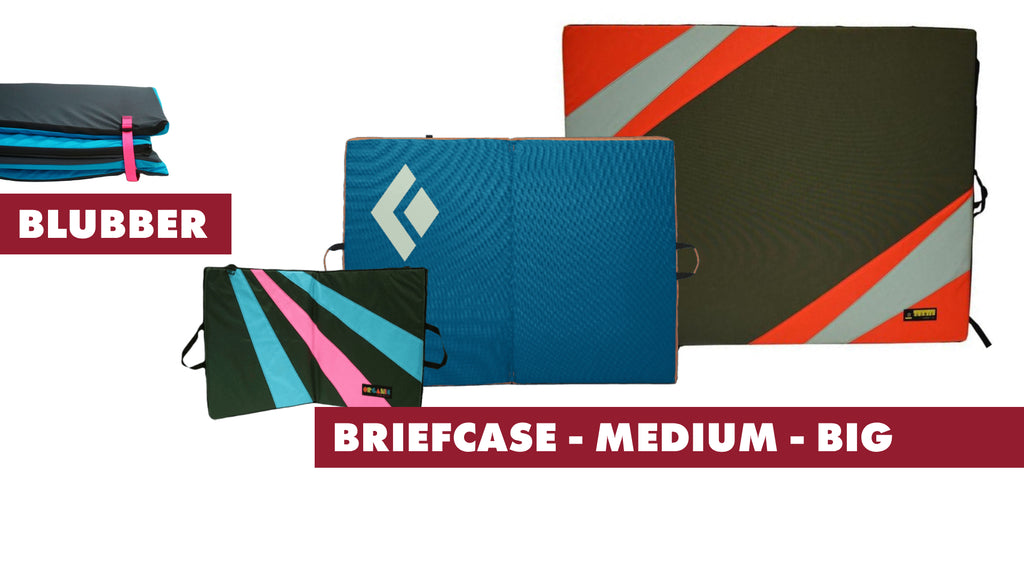
Pads shown above: Organic Blubber Pad, Organic Briefcase Pad, Black Diamond Circuit Pad, Organic Big Pad
When bouldering, the larger the area your pad covers, the safer your landing zone will be, making it beneficial to have pads of various sizes to accommodate different terrains and to fill gaps. Small pads can be effective if used strategically, but more coverage generally offers better protection.
Big
Big pads are ideal for big (think tall) boulders. They provide maximum foam coverage and most dedicated boulders will own at least one big pad as their main landing zone. When bouldering, the mantra is almost always "the more foam the better".
Medium (Standard)
Commonly known as "full pads" or standard pads, depending on the climber, these pads typically measure around 1 x 1.5 meters when unfolded. Their compact size offers several benefits: they are lighter and easier to transport, reducing the likelihood of snagging on trees or rocks during the approach. In areas with particularly rough landings, their smaller dimensions make them adept at conforming to irregular surfaces like protruding rocks or tree roots. Utilizing two medium pads can sometimes provide more versatile protection for a landing zone than relying on a single, larger pad.
Briefcase/Sliders/Minis/Small
These could also be called half pads, sliders, or small pads. They're pretty small and in most cases not entirely useful. If you're in an area with bad landings they can be nice to fill in holes or drape over rocks you might bounce off. They can also be good for placing at the start of problems with a sit start.
Sit / Blubber
Blubber pads are made of just one layer of stiff closed-cell foam, they are thin and flexible, and are ideal for smoothing uneven landing surfaces, layering atop other pads for added protection, or covering small gaps between larger pads in bouldering. They can also be used as thin coverage for sit starts boulder problems where a thicker pad would get in the way.
Foam Material
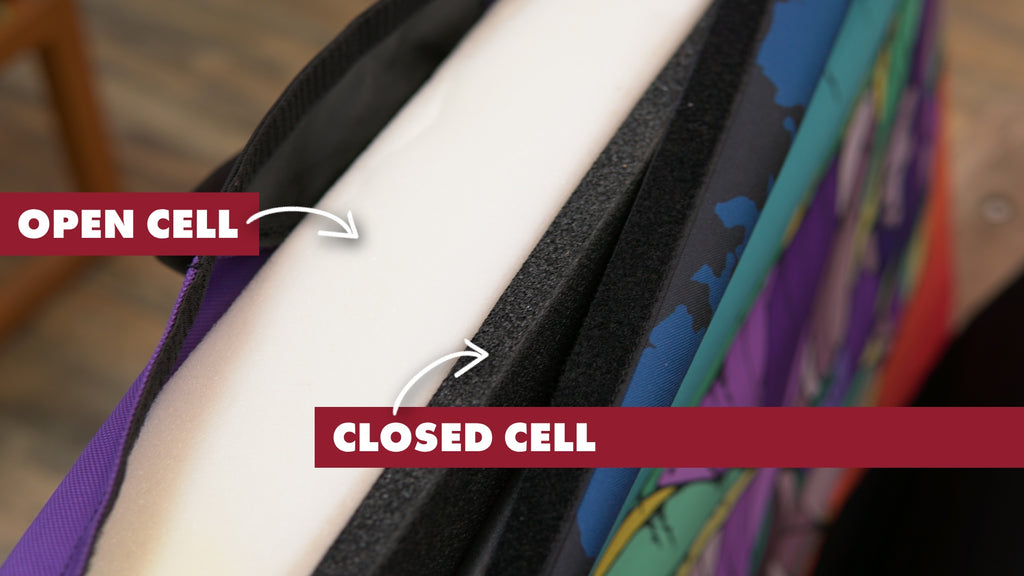
Above: Flashed Drifter Pad (With Chief Graphic)
Bouldering pads typically utilize a combination of foams to maximize impact absorption and durability. The two primary types of foam found in these pads are:
-
Closed-Cell Foam: This dense, firm foam is used in the outer layers of bouldering pads. Its compact structure offers a durable surface that spreads the force of a fall over a wider area. Closed-cell foam is less prone to compression over time, making it excellent for the top layer that initially absorbs the impact.
-
Open-Cell Foam: Softer and more cushioning, open-cell foam is used in the middle layers of bouldering pads. Its sponge-like structure allows for significant compression, which helps to absorb and dissipate the energy from a fall, reducing the impact felt by the climber. Over time, however, open-cell foam can compress more permanently, affecting its cushioning properties.
The combination of these foams in a bouldering pad creates a balance between shock absorption, durability, and comfort. Manufacturers may vary the thickness and density of each foam type to tailor the pad’s performance to different climbing styles and preferences.
Foam Quality
Not all foam is created equal. Prioritizing safety means investing in durable, cross-linked foam, which more effectively disperses the force of impact and has a longer lifespan. Cheaper foams tend to lose their firmness much more quickly. The key to longevity is in the polymer density of the foam; higher density equates to slower degradation and softening.
As a general guideline, heavier pads tend to be more durable and better equipped to handle larger falls. High-quality mats are characterized by their firmness, a direct result of the foam's dense structure. In contrast, lighter, less expensive mats may initially feel firm due to the use of chemical hardeners, which rapidly deteriorate, leaving behind a pad that becomes soft and floppy after minimal use.
Ideally, bouldering pads would use thick, soft, high-density natural PU foam, which absorbs energy slowly, cushioning falls more gently. However, this ideal is impractical due to the excessive weight, requiring a balance between cushioning, coverage of the landing zone, portability, and durability.
It's wise to steer clear of cheaper foam mats that rely on additives to artificially enhance firmness relative to their density. Although such mats may appear to offer a viable compromise by being lighter yet firm, this comes at the expense of durability. This explains why the foam in climbing pads can degrade and soften in just a few years, in contrast to the similar foam in mattresses, which can last a decade or more. Quality, high-density foam might be heavier and more costly upfront, but its longevity makes it a smarter investment. Lighter, hard foam may be cheaper, but it will quickly lose its firmness. Therefore, the weight of a mat is often a more reliable indicator of its quality than its initial firmness.
Foam Depth
Bouldering pads vary significantly in foam depth, each serving different needs in terms of protection, portability, and specific climbing scenarios.
- Approximately 1 inch: Blubber aka sit pads are extremely lightweight for the area they cover and are relatively easy to transport, by stuffing it inside a larger pad. They are usually made of one layer of closed cell foam and are specifically designed for adding an extra layer of protection, to cover the gaps between stacked pad and for very low, safe falls. The drawback to such a thin pad is it offers minimal impact absorption so is not suitable as the sole protection for most bouldering problems.
- Approximately 2-3 inches: These pads are lightweight, enhancing portability for long approaches or quick sessions and offer significantly more protection than thinner pads but are best suited to low-ball problems and filling uneven ground. We use these as a supplement to larger pads for additional protection. They do however tend to be less durable over time with frequent high-impact use.
- Approximately 3-4 inches: Standard pad depth pads are a good balance protection and portability for diverse bouldering styles.They offer enhanced impact absorption for moderate falls and are versatile across various terrains and bouldering problems. However are heavier and bulkier than thinner pads, complicating long approaches. They also may not provide sufficient protection for very high problems.
- Approximately 4 inches and above: Big, aka highball pads are amazing at high impact absorption, offering maximum safety for high falls. They are best suited for high-ball bouldering where fall protection is critical. They offer durable construction with high-quality foam for longevity but this comes at a price, both financially and increased weight & bulk. They are challenging to transport and not suitable to long approaches. Their bulk makes carrying and moving them harder but also potentially excessive for low-ball problems or close-to-ground bouldering.
Generally the thicker the foam the greater safety and confidence for high and risky problems plus enhanced pad longevity due to better absorption and less compression over time. However Increased price weight, and size, making transportation more difficult, especially for remote or hard-to-reach areas.
Selecting the appropriate pad depth should be based on the your requirements, favored bouldering styles, and a preference for the balance between ease of transport and level of protection.
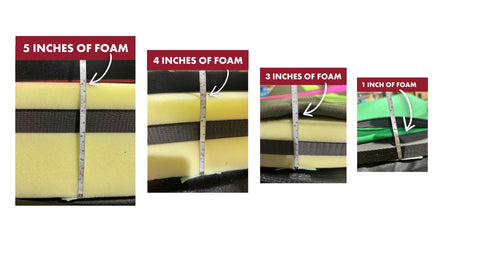
Shell Fabric
Bouldering pads typically feature a durable shell fabric, crucial for withstanding the rigors of outdoor use. Your pad is going to get jumped on, shoved down holes, and rubbed against rock and dirt, so it's crucial that the shell fabric is tough enough to meet the demands of bouldering. High-quality fabrics, like ballistic nylon or Cordura with high-denier yarns, enhance the pad's lifespan, resisting abrasions and tears.
Denier
The denier number refers to the thickness of the individual fibers in the fabric, with higher denier values indicating stronger and more robust material. One high-denier fabric commonly used in bouldering pads is Cordura. Cordura is a brand of polyamide (nylon) fabric known for its exceptional durability and resistance to abrasions, tears, and scuffs. It is available in various deniers, often ranging from 500D to 1000D or higher. Cordura is renowned for its toughness while remaining relatively lightweight. Some manufacturers use ballistic nylon with 1680 denier. This stuff is super strong and heavy, and will withstand everything nature can throw at it.

Above: 1680 Ballistic Nylon as found on the Flashed Drifter Pad
Weak Points
Consider the weak points in bouldering pads before purchasing. Examining seam and corner construction is crucial, as fewer seams enhance overall pad integrity. Robust zippers, especially heavy-duty varieties, are imperative for durability however most modern pads have switched to velcro for accessing foam compartments. Attention to detail extends to backpack straps; sturdiness prevents unexpected tears during transport. While Velcro aids in pad closure, its effectiveness may be compromised in moss-rich environments. Waterproof coatings add versatility, shielding against moisture. Combining these features ensures a comprehensive evaluation of a bouldering pad's durability, providing long lasting protection against wear and tear.
Folding Systems
Taco System (Hinge)
The Taco folding system involves a single fold, typically in half, creating a taco-like shape. These are probably the most common kinds of crash pad out there. This design provides a continuous landing surface without a central crease, offering seamless protection. Taco pads are convenient for quick setup and easy transportation.
However, larger taco-style pads tend to take up a lot of space and can be cumbersome to carry. The center seam can be a weak point in the pad and is often protected with a thin layer of closed-cell foam. Despite these considerations, the Taco system remains popular for its simplicity and quick deployment.

Above: Flashed Drifter Pad
Tri-Fold System (Hinge)
The Tri-Fold system divides the pad into three sections, folding like an accordion. This design allows for a compact size when folded, making it easy to carry. The threefold structure often includes hinges or straps to keep the sections aligned during use. These pads are usually large pads, providing coverage to a larger area.The downside to this is that there are more seams to potentially break and more spots to potentially hit a rock through the pad. Climbers opting for the Tri-Fold system prioritize portability, but careful consideration of the additional seams is essential to maintain the pad's overall durability and protection.

Above: Black Diamond Circuit Z Crash Pad
Burrito System
The Burrito folding system involves rolling the pad rather than folding it. This design often utilizes straps or buckles to secure the rolled pad, resembling a burrito. The Burrito system offers simplicity in packing and unpacking and can be advantageous for climbers who prefer a rolled configuration. These pads roll up to eliminate the need for seams on the surface of the pad. This is great for maximizing the surface area and safety of the landing zone, but the downside is that they can be a bit more annoying and more cumbersome to carry.
Baffled System
A bouldering pad with a baffled system integrates internal compartments, or baffles, enhancing impact distribution and foam stability during falls. This design minimizes the risk of bottoming out, providing a more reliable landing surface. While baffled systems offer improved safety through even impact absorption, they come with some trade-offs. The added complexity may increase the pad's weight, affecting portability, and manufacturing intricacies.
Folding System Summary
Bouldering pad folding systems, such as the Taco, Tri-Fold, and Burrito, determine how pads are compacted for transport. Tacos offer simplicity but may have a central seam weakness. Tri-Folds divide into three parts, prioritizing portability but with increased seam vulnerability. Burritos involve rolling, offering easy packing but sacrificing some protective elements. Each design suits different preferences and so climbers need to weight the pros and cons of each.
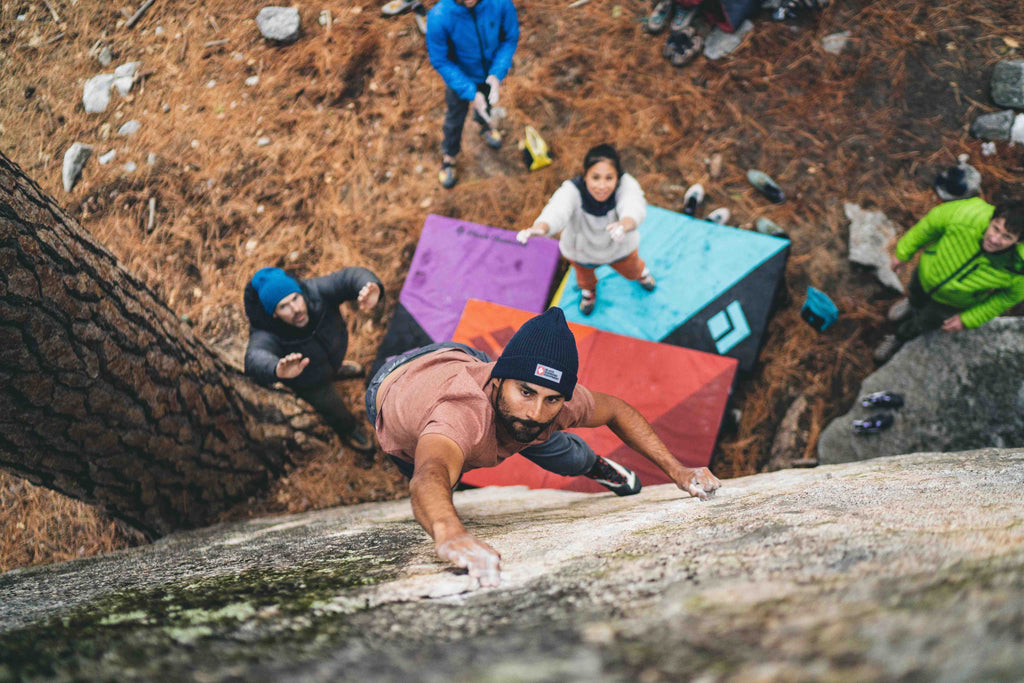
Carrying Systems
Carrying systems for bouldering pads vary, from simple shoulder straps to backpack-style options. Consider load size and quality, as a sturdy backpack system with a structural waist belt enhances comfort for heavier loads over longer distances. Are you going to strap 4 pads together so that you have a raft of pads under your highball project, or are you just going to bring one small pad?
Briefcase Style Handles - Most pads come with handles resembling a briefcase on multiple sides. They offer a different carrying option for short distances.
Backpack Carrying System - Bouldering pads equipped with a backpack carrying system provide a practical and comfortable solution for transporting gear. The backpack design allows climbers to carry their pads hands-free, promoting ease of movement and balance on the trail. These systems feature padded shoulder straps, distributing the pad's weight evenly for extended comfort during long approach hikes and additional compartments may be included for carrying essentials like water bottles, brushes and chalk. If a pad's backpack system isn't high quality, carrying in a bunch of weight can start to hurt fast. A good quality, structural waist belt can increase carrying comfort by transferring weight from the shoulders to the hips, and stabilizer straps help to keep the load stable.
Pad Attachments
If you plan on carrying more than one pad, it is worth understanding how different pads will accommodate this. Some pads work better with other pads within their brand and some work better with all pads. There is a multitude of ways that pads can attach. These vary in speed and durability. So take a look at the in-built system your pad is using and decide if you're willing to spend 15 minutes finicking between each boulder problem or want to add an additional attachment system
Multi Pad Carrying Systems - Flashed, Black Diamond and Organic have developed Multi Pad Carrying Systems. There are two basic types of carrying systems.
- Built-in Carrying Systems are designed and built into the pad upon purchase and allow a 2nd pad to be stacked onto the back of the first. Pads like the Flashed Drifter, Big Squishy and the Circuit or Mondo pad from Black Diamond come with built-in carrying systems
- Carry System Accessories are purchased separately as an additional piece of kit that expands the carrying capacity of most pads. If you have an existing pad, add the Organic Load Flap or the Piggyback carrying system by BD to allow you to quickly bundle up to 3 crash pads onto your back with ease.
Extended Straps - A simple but effective concept of extended your existing straps to connect additional pads.
Compression Straps - Utilizing compression straps, climbers can secure and streamline the transportation of multiple bouldering pads. By cinching the pads together, these straps create a more compact and manageable load. These straps can be purchased as a kit like the Sea to Summit Bomber Tie Down or can be or assembled by using webbing and buckles.
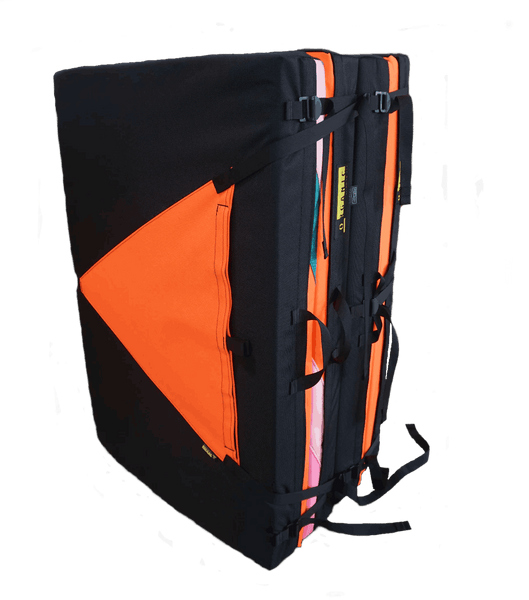
Bag Attachment
Consider how you are going to carry your extra gear to the boulders. Your shoes, chalk, brushes, tape, guidebook, food and water will all need transporting. How you pack these essentials will affect your day. One option is to stuff everything inside your bouldering pad; alternatively, you can carry a separate backpack, possibly attached to the pad or held alongside the boulder pads separately. Overstuffing your pad can strain the foam, allow stuff to fall out, and things become disorganized, so exploring external bag attachment options might be beneficial.
The bouldering pad manufacturers have considered the problem above and have created a few amazing products specifically cater to boulderers.
Organic Boulder Roll - This messenger styled bag with a roll down top can attach around your pad as a piggyback bag on outside of your pad when hiking. No more stuffing a pack into a folded pad
Flashed Frank Slider Pad - A versatile and stylish briefcase pad. The Frank Slider pad is equally ideal to carry your gear from work to the gym or around the boulders. The slim design can slide inside a large pad or the back strap can be extended to wrap around the outside of a standard pad. It even comes with with 3/4″ of closed cell foam covered with 1680 Ballistic nylon on the outside and soft fleece on top make this sidekick perfect for cleaning shoes, low-balls or covering side rocks.
BD Capsule 20 Bouldering Bag - This 20L bag is designed specifically to be carried inside a crash pad. It has multiple zip compartments stow your chalk and shoes separate from the rest of your kit; the shoe compartment is ventilated. A shoulder strap allows for easy carrying between problems and the bag fits neatly inside a pad for longer approaches.

Pad Care
Your crash pad may be designed to take a beating, but using proper care when cleaning and storing your pad will ensure you get years of service from your pad.
Pad Storage. Store your pad in a cool dry space out of directly sunlight,away from harmful chemicals and moisture or where animals can chew on them. Many a good pad has been ruined by tiny teeth! If you have space, try to store your pad in its natural state, open and uncompressed. Don't store it with a lot of weight sitting on it or with any folds as this can pack out the foam faster. If your pad gets wet make sure you dry it out or it can grow mould and stick.
Pad Cleaning. If the clean up is minor, just brush off the dust and dirt then use a damp rag and wipe it down. To give your bouldering pad a major clean, remove the foam and wash the shell with cold water and a bit of detergent in a bathtub. For pet odors, add a neutralizing cleaner. Rinse thoroughly and air dry. Clean the closed-cell foam with a damp cloth without wetting the open-cell foam. After drying, reassemble by inserting the open-cell layer, then the closed-cell, using the taco method for easier handling.
Pad Repair
Repairing the fabric of a pad is often inexpensive. However, if the foam starts to fall apart, it is often a better option to buy a new pad than to try and source new foam but there are a few repair options available to you.
Sewing
A knowledgeable seamstress can repair the outer fabric of a pad in a few minutes and will not cost too much, especially if you provide your own fabric. An effective solution for small rips or tears can be to hand sew the tear with a strong, durable thread. It's essential to use a needle that can penetrate the pad's tough fabric and a thread that won't easily break or wear out.
Professional Repair Services
Some manufacturers or outdoor gear repair shops offer professional repair services that can handle significant damage, including replacing sections of foam or fabric. This option can be costlier but results in a more reliable and long-lasting repair.
Foam Replacement
If the foam inside the pad has compressed or deteriorated significantly, replacing it can rejuvenate the pad's impact-absorbing capabilities. Some manufacturers sell replacement foam, or compatible foam can be cut to fit.
Patches
Specialized patches are available that are designed specifically for boulder pads, they give a custom look to your pad while repairing and covering tears in the shell fabric.
Duct Tape
A quick, temporary fix for minor damage. Duct tape can seal tears and prevent them from worsening, but it may leave a sticky residue and is less durable than other methods.
When repairing a bouldering pad, it's crucial to choose the method that best suits the extent of the damage and the pad's material. Proper repair can significantly extend the lifespan of the pad, maintaining its effectiveness and safety.













Leave a comment